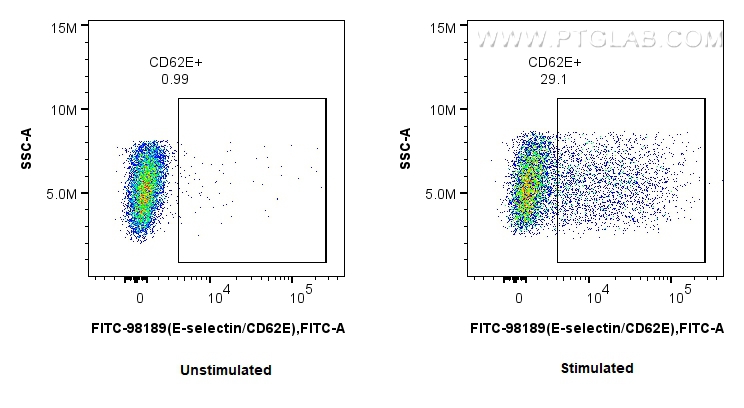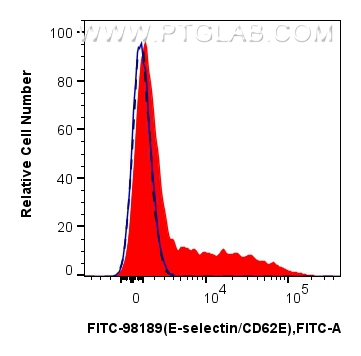验证数据展示
经过测试的应用
| Positive FC detected in | TNF alpha treated HUVEC cells |
推荐稀释比
| 应用 | 推荐稀释比 |
|---|---|
| This reagent has been pre-titrated and tested for flow cytometric analysis. The suggested use of this reagent is 5 ul per 10^6 cells in a 100 µl suspension or 5 ul per 100 µl of whole blood. | |
| Sample-dependent, Check data in validation data gallery. | |
产品信息
FITC-98189 targets E-selectin/CD62E in FC applications and shows reactivity with human samples.
| 经测试应用 | FC Application Description |
| 经测试反应性 | human |
| 免疫原 | Recombinant Protein 种属同源性预测 |
| 宿主/亚型 | Rabbit / IgG |
| 抗体类别 | Recombinant |
| 产品类型 | Antibody |
| 全称 | selectin E |
| 别名 | CD62E, E-selectin, 241767H6, CD62 antigen-like family member E, E selectin |
| 计算分子量 | 610 aa, 67 kDa |
| GenBank蛋白编号 | BC142711 |
| 基因名称 | CD62E |
| Gene ID (NCBI) | 6401 |
| 偶联类型 | FITC Plus Fluorescent Dye |
| 最大激发/发射波长 | 495 nm / 524 nm |
| 形式 | Liquid |
| 纯化方式 | Protein A purification |
| UNIPROT ID | P16581 |
| 储存缓冲液 | PBS with 0.09% sodium azide and 0.5% BSA , pH 7.3 |
| 储存条件 | Store at 2-8°C. Avoid exposure to light. Stable for one year after shipment. |
背景介绍
E-selectin, also known as CD62E or ELAM-1, is a member of the selectin family of adhesion molecules that also includes L-selectin and P-selectin. E-selectin is an inducible endothelial cell surface molecule. Its expression on endothelial cells is transcriptionally upregulated by various proinflammatory substances such as IL-1, TNFα and lipopolysaccharide (LPS). Besides, it can be secreted by endothelial cells, and can be detected in a soluble form (sE-selectin) in serum. During inflammation, E-selectin plays an important part in recruiting leukocytes to the site of injury. (PMID: 2827173; 1382417; 8943958)
实验方案
| Product Specific Protocols | |
|---|---|
| FC protocol for FITC Plus E-selectin/CD62E antibody FITC-98189 | Download protocol |
| Standard Protocols | |
|---|---|
| Click here to view our Standard Protocols |

